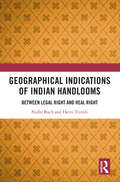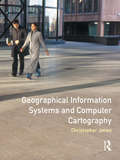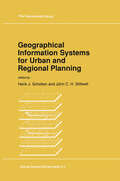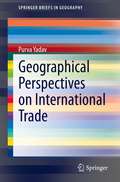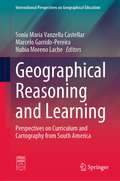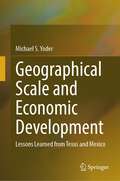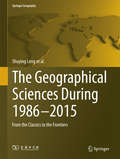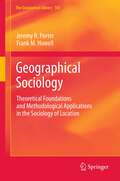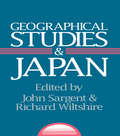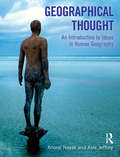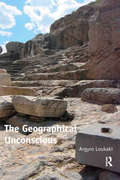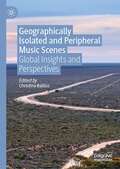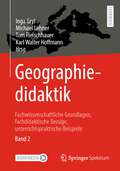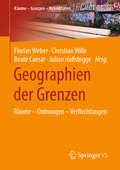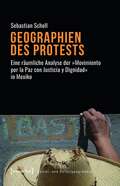- Table View
- List View
A Geographical Guide to the Real and the Good
by Robert SackFirst published in 2003. Routledge is an imprint of Taylor & Francis, an informa company.
A Geographical Guide to the Real and the Good
by Robert SackFirst published in 2003. Routledge is an imprint of Taylor & Francis, an informa company.
Geographical Indications of Indian Handlooms: Between Legal Right and Real Right
by Nidhi Buch Hetvi TrivediThis book presents a comprehensive analysis of Geographical Indications (GI) in the Indian context with particular reference to the handloom sector. It discusses themes such as the rationale of GI as IP (intellectual property); the domestic position on GIs; GI protection under various international instruments; handlooms from Gujarat and their GI journey; the efficacy of GIs; and GI structure for handlooms. The volume fills the gap between law and policies and recommends the implementation of an efficient legal system. It highlights the status of Indian handlooms, a sector that represents the country’s cultural heritage and supports a range of livelihoods. We examine India’s GI protection system with its diverse cultures and explore how GI can help recognize, support and promote these products to bring socio-economic benefits. The work documents policy measures undertaken for the revival, restructuring and promotion of Indian handlooms and handicrafts, and will serve as an important intervention in Indian law on GI. An investigative study that evaluates the current law and policy on GI protection through detailed case studies and empirical research on select Indian handlooms, this book will be useful to scholars and researchers of geography, economics, development studies, sociology, law and public policy. It will also interest policymakers, legal practitioners, textile and handloom professionals, design and business administration institutes, media, arts and crafts museums and civil society organizations working on handlooms or in intellectual property.
Geographical Indications of Indian Handlooms: Between Legal Right and Real Right
by Nidhi Buch Hetvi TrivediThis book presents a comprehensive analysis of Geographical Indications (GI) in the Indian context with particular reference to the handloom sector. It discusses themes such as the rationale of GI as IP (intellectual property); the domestic position on GIs; GI protection under various international instruments; handlooms from Gujarat and their GI journey; the efficacy of GIs; and GI structure for handlooms. The volume fills the gap between law and policies and recommends the implementation of an efficient legal system. It highlights the status of Indian handlooms, a sector that represents the country’s cultural heritage and supports a range of livelihoods. We examine India’s GI protection system with its diverse cultures and explore how GI can help recognize, support and promote these products to bring socio-economic benefits. The work documents policy measures undertaken for the revival, restructuring and promotion of Indian handlooms and handicrafts, and will serve as an important intervention in Indian law on GI. An investigative study that evaluates the current law and policy on GI protection through detailed case studies and empirical research on select Indian handlooms, this book will be useful to scholars and researchers of geography, economics, development studies, sociology, law and public policy. It will also interest policymakers, legal practitioners, textile and handloom professionals, design and business administration institutes, media, arts and crafts museums and civil society organizations working on handlooms or in intellectual property.
Geographical Information Systems: A Practical Approach
by Xuan ZhuGeographical information systems (GIS) are powerful tools for reporting on the environment, natural resources and social and economic development; modelling the environmental, biophysical, social and economic processes; assessing environmental and social impacts; evaluating environmental, social and economic policies and actions and dissimilating spatial information. Geographical Information Systems: A Practical Approach provides the fullest available introduction to GIS and their environmental, social and economic applications. This new edition has been substantially revised and updated to incorporate the key developments in GIS technology and spatial data science and their applications that have taken place in recent years.The key features include: A comprehensive coverage of concepts, methods, techniques and tools in GIS for spatial data capturing, processing, visualisation, analysis, modelling and decision-making Incorporation of advanced machine learning techniques for spatial data analysis and modelling Extended coverage of spatial visualisation with 3D mapping and online mapping Weaving together of GIS theory and practice to help readers learn important GIS concepts and methods and develop their understanding through practicals with ArcGIS Pro or QGIS New and updated case studies illustrating the innovative use of GIS for a wide range of applications The second edition of this text continues to bring up-to-date GIS knowledge, tools and practices into one cohesive, comprehensive, concise and self-contained book which is accessible to students, scientists and practitioners in environmental science, earth science, geography, archaeology and other scientific studies that have a spatial dimension.
Geographical Information Systems: A Practical Approach
by Xuan ZhuGeographical information systems (GIS) are powerful tools for reporting on the environment, natural resources and social and economic development; modelling the environmental, biophysical, social and economic processes; assessing environmental and social impacts; evaluating environmental, social and economic policies and actions and dissimilating spatial information. Geographical Information Systems: A Practical Approach provides the fullest available introduction to GIS and their environmental, social and economic applications. This new edition has been substantially revised and updated to incorporate the key developments in GIS technology and spatial data science and their applications that have taken place in recent years.The key features include: A comprehensive coverage of concepts, methods, techniques and tools in GIS for spatial data capturing, processing, visualisation, analysis, modelling and decision-making Incorporation of advanced machine learning techniques for spatial data analysis and modelling Extended coverage of spatial visualisation with 3D mapping and online mapping Weaving together of GIS theory and practice to help readers learn important GIS concepts and methods and develop their understanding through practicals with ArcGIS Pro or QGIS New and updated case studies illustrating the innovative use of GIS for a wide range of applications The second edition of this text continues to bring up-to-date GIS knowledge, tools and practices into one cohesive, comprehensive, concise and self-contained book which is accessible to students, scientists and practitioners in environmental science, earth science, geography, archaeology and other scientific studies that have a spatial dimension.
Geographical Information Systems and Computer Cartography
by Chris B. JonesA concise text presenting the fundamental concepts in Geographical Information Systems (GIS), emphasising an understanding of techniques in management, analysis and graphic display of spatial information.Divided into five parts - the first part reviews the development and application of GIS, followed by a summary of the characteristics and representation of geographical information. It concludes with an overview of the functions provided by typical GIS systems. Part Two introduces co-ordinate systems and map projections, describes methods for digitising map data and gives an overview of remote sensing. Part Three deals with data storage and database management, as well as specialised techniques for accessing spatial data. Spatial modelling and analytical techniques for decision making form the subject of Part Four, while the final part is concerned with graphical representation, emphasising issues of graphics technology, cartographic design and map generalisation.
Geographical Information Systems and Computer Cartography
by Chris B. JonesA concise text presenting the fundamental concepts in Geographical Information Systems (GIS), emphasising an understanding of techniques in management, analysis and graphic display of spatial information.Divided into five parts - the first part reviews the development and application of GIS, followed by a summary of the characteristics and representation of geographical information. It concludes with an overview of the functions provided by typical GIS systems. Part Two introduces co-ordinate systems and map projections, describes methods for digitising map data and gives an overview of remote sensing. Part Three deals with data storage and database management, as well as specialised techniques for accessing spatial data. Spatial modelling and analytical techniques for decision making form the subject of Part Four, while the final part is concerned with graphical representation, emphasising issues of graphics technology, cartographic design and map generalisation.
Geographical Information Systems for Urban and Regional Planning (GeoJournal Library #17)
by Henk J. Scholten and John C. H. StillwellIn August 1989, a Summer Institute was held at the Academie van Bouwkunst, the seventeenth century home of Amsterdam's School of Architecture, Town Planning and Landscape. The meeting brought together experts in Geographical Information Systems from throughout the world to address an international audience of planners. The contents of this book reflect many of the themes that were presented and discussed at the conference. The Summer Institute, let alone this volume, would not have been possible without the support of the International Association for the Development and Management of Existing and New Towns (INTNAIVN), the International Society of City and Regional Planners (ISoCaRP), The National Physical Planning Agency of the Netherlands (RPD) and the Berlage Studio. We wish to acknowledge the assistance provided by these organisations and by the various sponsors: The Ministry of Housing, Physical Planning and Environment, the Municipality of Amsterdam, Logisterion b.v., ESRI, UNISYS, MABON b.v., SPSS, PRIME Computer Inc., PANDATA. The provision of hardware facilities by the various computer companies allowed immensely valuable 'hands on' experience to be gained by all the participants.
Geographical Perspectives on International Trade (SpringerBriefs in Geography)
by Purva YadavThis book analyzes spatial and temporal patterns of international trade from a geographical perspective. Trade is an important key to understanding the changing dynamics of economic spaces over time. However, studies by geographers are largely confined to case studies, whereas the spatial dimension is often missing from the approach of economists. This study highlights spatial patterns and commodity composition of global trade and the nature of relationship between trade and other economic attributes. A case study of the MERCOSUR trade block examines inter-regional and intra-regional trade flows. The book captures a comprehensive picture of the structure of international exchange by using ample maps and illustrations as supporting features. Many different methods are applied such as the location quotient to capture concentration and diversification of commodity composition, data reduction techniques such as factor analysis and regression models for relating the economic structures and trade patterns as well as residual mapping among others. This book is a significant contribution to geographical, economical and social sciences research and very useful to graduate and post-graduate students as well as scientists of all related areas who have interest in exploring the changing dynamics of the global economy via trade flows. It provides a road map to further explore different dimensions of international trade and its role in understanding the transforming global economy.
Geographical Reasoning and Learning: Perspectives on Curriculum and Cartography from South America (International Perspectives on Geographical Education)
by Sonia Maria Vanzella Castellar Marcelo Garrido-Pereira Nubia Moreno LacheThis book presents the distinctive theoretical and methodological approaches in geography education in South America and more specifically in Brazil, Chile and Colombia. It highlights cartography and maps as essential tools and provides a meaningful approach to learning in geographical education, thereby giving children and young people the opportunity to better understand their situations, contexts and social conditions. The book describes how South American countries organize their scholar curriculum and the ways in which they deal with geography vocabulary and developing fundamental concepts, methodologies, epistemological comprehension on categories, keywords and themes in geography. It also describes its use in teachers’ practices and learning progressions, the use of spatial representations as a potent mean to visualize and solve questions, and harnesses spatial thinking and geographical reasoning development. The book helps to improve teaching and learning practices in primary and secondary education and as such it provides an interesting read for researchers, students, and teachers of geography and social studies.
Geographical Scale and Economic Development: Lessons Learned from Texas and Mexico
by Michael S. YoderThis book is an attempt to bridge the academic discipline of economic geography with the professional field of economic development. Through case studies of economic development, it illustrates two fundamental concepts of the sub-discipline of economic geography: scale and spatial connections. It demonstrates some of the ways that economic development policies and plans are linked globally, nationally, regionally, and locally. It ties together several studies of communities and transportation systems in Texas and Mexico carried out from the late 2010’s through 2021. The studies shed light on the need to study economic development at multiple scales and to do so through blended qualitative research methods that include conversations with economic development stakeholders, published data, news content from the business and trade media, and direct observation of the built environment.The book is a set of narratives that combine descriptions of the evolution of commercial transportation systems, economic promotion in selected communities, and corresponding changes in the built environment. It is organized into three sections, each of which corresponds to a different scale at which economic development functions: macro, regional, and local.
The Geographical Sciences During 1986—2015: From the Classics To the Frontiers (Springer Geography)
by Shuying Leng Xizhang Gao Tao Pei Guoyou Zhang Liangfu Chen Xi Chen Canfei He Daming He Xiaoyan Li Chunye Lin Hongyan Liu Weidong Liu Yihe Lü Shilong Piao Qiuhong Tang Fulu Tao Lide Tian Xiaohua Tong Cunde Xiao Desheng Xue Linsheng Yang Linwang Yuan Yuanming Zheng Huiyi Zhu Liping ZhuIn four chapters and an introduction, this book systematically helps readers understand the development of the Geographical Sciences both in China and in the world during the past 30 years. Through data analysis of methodologies including CiteSpace, TDA, qualitative analysis, questionnaires, data mining and mathematical statistics, the book explains the evolution of research topics and their driving factors in the Geographical Sciences and its four branches, namely Physical Geography, Human Geography, Geographical Information Science and Environmental Geography. It also identifies the role of the Geographical Sciences in the analysis of strategic issues such as global change and terrestrial ecosystems, terrestrial water cycle and water resources, land change, global cryosphere evolution and land surface processes on the Tibetan Plateau, economic globalization and local responses, regional sustainable development, remote sensing modelling and parameter inversion, spatial analysis and simulation, and tempo-spatial processes and modelling of environmental pollutants. It then discusses research development and inadequacy of Chinese Geographical Sciences in the above-mentioned topics, as well as in the fields including Geomorphology and Quaternary environmental change, Ecohydrology, ecosystem services, the urbanization process and mechanism, medical and health geography, international rivers and transboundary environment and resources, detection and attribution of changes in land surface sensitive components, and uncertainty of spatial information and spatial analysis. It shows that the NSFC has driven the development in all these topics and fields. In addition, the book summarises trends of the Geographical Sciences in China and the research level in major countries of the world through an overview of geographical education in colleges and universities, the analysis of publications, citations and author networks of SCI/SSCI and CSCD indexed articles, and the description of Sino-USA, Sino-UK and Sino-German cooperation. This book serves as an important reference to anyone interested in geographical sciences and related fields.
Geographical Sociology: Theoretical Foundations and Methodological Applications in the Sociology of Location (GeoJournal Library #105)
by Jeremy R. Porter Frank M. HowellThe discipline of Sociology has a rich history of including spatial context in the analysis of social issues. Much of this history has revolved around the development and application of spatial theory aimed at understanding the geographic distribution of social problems, the organization of communities, and the relationship between society and the environment. More recently, the social sciences have seen a large number of technological innovations that now make it possible to place social behaviour in spatial context. Consequently, because of the historical disjuncture in the development of spatial theory and the recent development of relevant methodological tools, the relationship between materials describing both the methodological approaches and their theoretical importance a scattered throughout various books and articles. Geographical Sociology consolidates these materials into a single accessible source in which spatial concepts such as containment, proximity, adjacency, and others are examined in relation to such methodological tools as hierarchical linear models, point pattern analysis, and spatial regression. As these methods continue to increase in popularity among social scientists the ability to more generally understand societies relationship to geographic space will continue to increase in it importance in the field. This book represents a starting point to linking these concepts to practice and is presented in an accessible form in which students, researchers, and educators can all learn, and in turn, contribute to its development.
Geographical Studies and Japan
by John Sargent Richard WiltshireDescribes the trends, diversity and differences in Japanese and British geographical studies.
Geographical Studies and Japan
by John Sargent Richard WiltshireDescribes the trends, diversity and differences in Japanese and British geographical studies.
Geographical Thought: An Introduction to Ideas in Human Geography
by Anoop Nayak Alex JeffreyGeographical Thought provides a clear and accessible introduction to the key ideas and figures in human geography. The book provides an essential introduction to the theories that have shaped the study of societies and space. Opening with an exploration of the founding concepts of human geography in the nineteenth century academy, the authors examine the range of theoretical perspectives that have emerged within human geography over the last century from feminist and marxist scholarship, through to post-colonial and non-representational theories. Each chapter contains insightful lines of argument that encourage readers towards independent thinking and critical evaluation. Supporting materials include a glossary, visual images, further reading suggestions and dialogue boxes.
Geographical Thought: An Introduction to Ideas in Human Geography
by Anoop Nayak Alex JeffreyGeographical Thought provides a clear and accessible introduction to the key ideas and figures in human geography. The book provides an essential introduction to the theories that have shaped the study of societies and space. Opening with an exploration of the founding concepts of human geography in the nineteenth century academy, the authors examine the range of theoretical perspectives that have emerged within human geography over the last century from feminist and marxist scholarship, through to post-colonial and non-representational theories. Each chapter contains insightful lines of argument that encourage readers towards independent thinking and critical evaluation. Supporting materials include a glossary, visual images, further reading suggestions and dialogue boxes.
The Geographical Unconscious
by Argyro LoukakiThis ambitious and innovative volume stretches over time and space, over the history of modernity in relation to antiquity, between East and West, to offer insights into what the author terms the 'geographical unconscious.' She argues that, by tapping into this, we can contribute towards the reinstatement of some kind of morality and justice in today's troubled world. Approaching selected moments from ancient times to the present of Greek cultural and aesthetic geographies on the basis of a wide range of sources, the book examines diachronic spatiotemporal flows, some of which are mainly cultural, others urban or landscape-related, in conjunction with parallel currents of change and key issues of our time in the West more generally, but also in the East. In doing so, The Geographical Unconscious reflects on visual and spatial perceptions through the ages; it re-considers selective affinities plus differences and identifies enduring age-old themes, while stressing the deep ancient wisdom, the disregarded relevance of the aesthetic, and the unity between human senses, nature, and space. The analysis provides new insights towards the spatial complexities of the current age, the idea of Europe, of the East, the West, and their interrelations, as well as the notion of modernity.
The Geographical Unconscious
by Argyro LoukakiThis ambitious and innovative volume stretches over time and space, over the history of modernity in relation to antiquity, between East and West, to offer insights into what the author terms the 'geographical unconscious.' She argues that, by tapping into this, we can contribute towards the reinstatement of some kind of morality and justice in today's troubled world. Approaching selected moments from ancient times to the present of Greek cultural and aesthetic geographies on the basis of a wide range of sources, the book examines diachronic spatiotemporal flows, some of which are mainly cultural, others urban or landscape-related, in conjunction with parallel currents of change and key issues of our time in the West more generally, but also in the East. In doing so, The Geographical Unconscious reflects on visual and spatial perceptions through the ages; it re-considers selective affinities plus differences and identifies enduring age-old themes, while stressing the deep ancient wisdom, the disregarded relevance of the aesthetic, and the unity between human senses, nature, and space. The analysis provides new insights towards the spatial complexities of the current age, the idea of Europe, of the East, the West, and their interrelations, as well as the notion of modernity.
Geographically Isolated and Peripheral Music Scenes: Global Insights and Perspectives
by Christina BallicoThis book explores the influence of geographical isolation and peripherality on the functioning of music industries and scenes which operate within and from such locales. As is explored, these sites engage dynamic practices to offset challenges resulting from geographical isolation and peripherality.
Geographiedidaktik: Fachwissenschaftliche Grundlagen, fachdidaktische Bezüge, unterrichtspraktische Beispiele - Band 2
by Inga Gryl Michael Lehner Tom Fleischhauer Karl Walter HoffmannMit dem zweibändigen Werk liegt das erste deutschsprachige Lehrbuch zur Geographiedidaktik vor, welches konkret zum kreativen und praxistauglichen Verknüpfen von fachwissenschaftlichen und fachdidaktischen Bezügen anregt. Mit Hilfe eines „Didaktischen Mischpults“ sollen mannigfaltige didaktische Variations- und Kombinationsmöglichkeiten gelingen. Hierfür stehen neben dem klassischen Inhaltsverzeichnis fünf weitere Verzeichnisse zur Verfügung, die einen einfachen Zugriff auf die einzelnen Abschnitte der jeweiligen Beiträge (geographiedidaktische Bezüge, fachwissenschaftliche Bezüge, Basiskonzepte, Kompetenzen, räumliche Bezüge) ermöglichen und somit ein eigenständiges (Re-)Mixen erleichtern. Außerdem stehen zu vielen Beiträgen konkrete Arbeitsmaterialien und editierbare Druckvorlagen in einem digitalen Materialanhang bereit.Die Gesamtkonzeption des Werks betont die Interdisziplinarität des Fachs Geographie im Bezug zu Natur- und Gesellschaftswissenschaften und stellt die Verflechtung beider Bereiche als Normalfall dar. Mit Blick auf die fachwissenschaftlichen Bezugspunkte und die Orientierung in Lehrplänen werden in Band 1 naturwissenschaftliche und in Band 2 gesellschaftswissenschaftliche zentrierte Anwendungsbezüge dargestellt, aber stets mit interdisziplinären Bezügen im Bereich Mensch-Umwelt-System, da vor dem Hintergrund von Vernetzung und Komplexität keine scharfe Trennung möglich und sinnvoll ist. Beide Bände beinhalten zudem methodische Themen, die im Band 1 die technischen Grundlagen und im Band 2 die sozialgeographischen Implikationen in einer Kultur der Digitalität fokussieren.Die beiden Bände sind ein umfassendes Gemeinschaftswerk, das verschiedene Professionen und Expertisen vereint. Die 83 Autor*innen aus der gesamten deutschsprachigen Community der Geographiedidaktik sind in Schulpraxis, Lehramtsausbildung und/oder fachdidaktischer Forschung tätig. Leitend ist dabei eine theoretisch und empirisch fundierte, reflektierte Praxis. Damit richtet sich das Werk an Schulpraktiker*innen, Lehrer*innen, Referendar*innen, Studierende, Fachdidaktiker*innen, Lehramtsbildner*innen, Theoretiker*innen und Interessierte.
Geographien der Grenzen: Räume – Ordnungen – Verflechtungen (Räume – Grenzen – Hybriditäten)
by Florian Weber Christian Wille Beate Caesar Julian HollsteggeDer Sammelband diskutiert den Zusammenhang von Räumen, Ordnungen und Verflechtungen. Die Autor*innen aus den Raum-, Sozial- und Kulturwissenschaften wählen unterschiedliche Zugänge zu Grenzen und analysieren ihre (Re-)Produktionsprozesse als ‚Geographien der Grenzen‘. Dabei rücken sie auch andere als nationalstaatliche Grenzen in den Blick, wie zum Beispiel stadtlandhybride Differenzierungen. So wird in diesem Band aus verschiedenen theoretischen und thematischen Blickwinkeln der Frage nachgegangen, wie und welche ,Geographien der Grenzen‘ sich im Zusammenspiel von unterschiedlichen Destabilisierungen und (Re-)Stabilisierungen von Grenzen (re)konstruieren lassen.
Geographien der Kolonialität: Geschichten globaler Ungleichheitsverhältnisse der Gegenwart (Sozial- und Kulturgeographie #46)
by Sybille Bauriedl Inken Carstensen-EgwuomKolonialismus ist ein historisches Thema, ein Gegenwartsthema und ein geographisches Thema. Die Beiträger*innen des Bandes verbinden diese drei Perspektiven und zeigen die Relevanz räumlicher und sozialer Machtverhältnisse des Kolonialismus in der Gegenwart auf. Diese »Kolonialität« genannte Kontinuität zeigt sich in der Wissensproduktion, in öffentlichen Debatten, in der Gestalt europäischer Städte, in lokalen Kämpfen sowie internationalen Politikfeldern. Der Sammelband vereint Beiträge aus der Geographie und Stadtforschung, die sich auf Forschungsansätze der Black Studies, Postcolonial Studies und Decolonial Studies beziehen.
Geographien des Protests: Eine räumliche Analyse der »Movimiento por la Paz con Justicia y Dignidad« in Mexiko (Sozial- und Kulturgeographie #35)
by Sebastian SchollWie und wozu nutzen soziale Bewegungen »Raum«? Sebastian Scholl nimmt sich dieser grundlegenden Fragestellung mit interdisziplinären Zugängen an. Ins Zentrum stellt er dabei die Analyse der Funktion von Raum für die Aktivitäten von Protestbewegungen in öffentlich nicht sichtbaren Protestphasen. Auf Grundlage der Theorie sozialer Systeme sowie empirischer Einblicke in die mexikanische Friedensbewegung »Movimiento por la Paz con Justicia y Dignidad« - die sich im Kontext des sogenannten »Kriegs gegen die Drogen« formiert hat - wird erstmals eine Perspektive entworfen, die die Zusammenhänge von aktiven und latenten Protestphasen in raumbezogener Hinsicht analysierbar macht.

